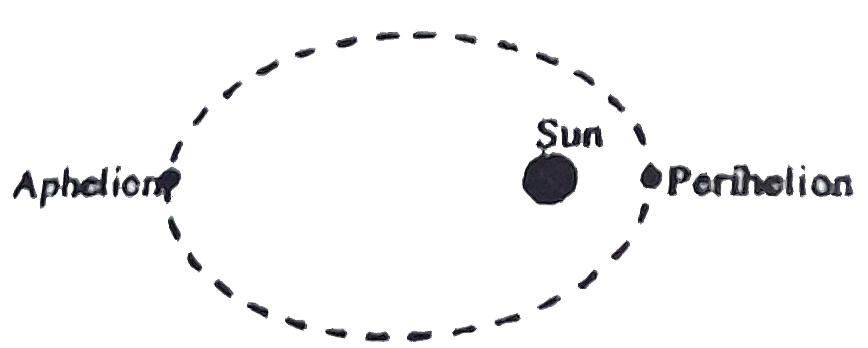The orbit of Plus is much more eccentric than the orbits of the other planets. That is, instead of being nearly circular, the orbit is noticeably elliptical. The point in the orbit nearest the Sun is called the aphelion.

At perihelion, the mechanical energy of Pluto's orbit has.
its maximum
its minimum value
the same value as very other point in the orbit
value which depend on sense of rotation
The correct Answer is:C
Total energy = constant
Topper's Solved these Questions
- TEST PAPERSBOOK - BANSALCHAPTER - TEST PAPERSEXERCISE - PHYSICS SECTION - 1 [MULTIPLE CORRECT CHOICE TYPE]
6 Videos
- TEST PAPERSBOOK - BANSALCHAPTER - TEST PAPERSEXERCISE - CHEMISTRY SECTION - 2 PART A [SINGLE CORRECT CHOICE TYPE]
8 Videos
- TEST PAPERSBOOK - BANSALCHAPTER - TEST PAPERSEXERCISE - MATHS SECTION-3 PART-C [INTEGER TYPE]
5 Videos
- PROBABILITYBOOK - BANSALCHAPTER - PROBABILITYEXERCISE - All Questions
1 Videos
- THERMODYNAMICSBOOK - BANSALCHAPTER - THERMODYNAMICSEXERCISE - Match the column
7 Videos
Similar Questions
The orbit of Pluto is much more eccentric than the orbits of the other planets. That is, instead of being nearly circular, the orbit is noticeably elliptical. The point in the orbit nearest to the Sun is called the perihelion and the point farthest from the Sun is called the aphelion.

At perihelion, the mechanical energy of Pluto's orbit has
View SolutionThe orbit of Pluto is much more eccentric than the orbits of the other planets. That is, instead of being nearly circular, the orbit is noticeably elliptical. The point in the orbit nearest to the sun is called the perihelion and the point farthest from the sun is called the aphelion.

At perihelion, the mechanical energy of Pluto’s orbit has
View Solution
Knowledge Check
The orbit of Pluto is much more eccentric than the orbits of the other planets. That is, instead of being nearly circular, the orbit is noticeably elliptical. The point in the orbit nearest to the Sun is called the perihelion and the point farthest from the Sun is called the aphelion.

At perihelion, the mechanical energy of Pluto's orbit hasAits maximum valueBits minimum valueCthe same value at every other point in the orbitDthe value which depends on the sense of rotationThe orbit of Pluto is much more eccentric than the orbits of the other planets. That is, instead of being nearly circular, the orbit is noticeably elliptical. The point in the orbit nearest to the Sun is called the perihelion and the point farthest from the Sun is called the aphelion.

As Pluto moves from the perihelion to the aphelion, the work done by gravitational pull of Sun on Pluto isAis zeroBis positiveCis negativeDdepends on sence of rotationThe orbit of Pluto is much more eccentric than the orbits of the other planets. That is, instead of being nearly circular, the orbit is noticeably elliptical. The point in the orbit nearest to the Sun is called the perihelion and the point farthest from the Sun is called the aphelion.

At perihelion, the gravitational potential energy of Pluto in its orbit hasAits maximum valueBits minimum valueCthe same value at every other point in the orbitDthe value which depends on the sense of rotation
The orbit of Pluto is much more eccentric than the orbits of the other planets. That is, instead of being nearly circular, the orbit is noticeably elliptical. The point in the orbit nearest to the Sun is called the perihelion and the point farthest from the Sun is called the aphelion.

As Pluto moves from the perihelion to the aphelion, the work done by gravitational pull of Sun on Pluto is
View SolutionThe orbit of Pluto is much more eccentric than the orbits of the other planets. That is, instead of being nearly circular, the orbit is noticeably elliptical. The point in the orbit nearest to the sun is called the perihelion and the point farthest from the sun is called the aphelion.

As Pluto moves from the perihelion to the aphelion, the work done by gravitational pull of Sun on Pluto is
View SolutionThe orbit of Pluto is much more eccentric than the orbits of the other planets. That is, instead of being nearly circular, the orbit is noticeably elliptical. The point in the orbit nearest to the Sun is called the perihelion and the point farthest from the Sun is called the aphelion.

At perihelion, the gravitational potential energy of Pluto in its orbit has
View SolutionThe orbit of Pluto is much more eccentric than the orbits of the other planets. That is, instead of being nearly circular, the orbit is noticeably elliptical. The point in the orbit nearest to the sun is called the perihelion and the point farthest from the sun is called the aphelion.

At perihelion, the gravitational potential energy of Pluto in its orbit has
View SolutionA satellite is in an elliptical orbit around the earth with aphelion of 6RE and perihelion of 3RE, where RE is the radius of the earth. The eccentricity of the orbit is
View Solution
